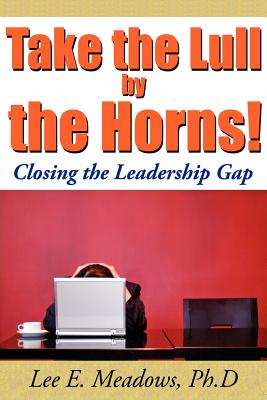Why Take the Lull by the Horns!: Closing the Leadership Gap is important all all business leaders and employees
by Lee E. Meadows
What leadership opportunities did you miss today? The inherent, and often times unstated, responsibility of those who lead is to insure that a leadership void does not appear anywhere on the organizational continuum. The ebb and flow nature of organizational structures requires a certain level of internal stability and consistency so it doesn’t crumble the first time it encounters an unexpected problem. The classic approach to resolving this problem, when times are good, is to throw money and latest management tool at the problem. While this approach has often lead to a lot of chest thumping, ego pumping rides up the corporate escalator, it also reaffirms that what gets advanced doesn’t necessarily qualify as leadership, but is typically gingerbread cookies shaped in the same image and baked in the same way. Predictability is affordable when nothing else matters. However, these early years of the 21st century have more than demonstrated that quite a bit matters and gingerbread cookies are a leadership luxury we cannot afford.
The real trick, for most organizations, is to recognize that the search for a competitive edge comes down to knowing how to fill the leadership void when times are not so predictable. Globalization should be synonymous with unpredictability while leadership should be the antithesis of tradition. The relationship between leadership and globalization is, at best, a volatile marriage in need of a therapist to help sort through the issues in order to find a common ground in which to build a foundation for success. When a certain level of dysfunction begins to bounce from cubicle to cubicle, the tendency is to look to previously tried methods to lead the organization through its current crisis. Unfortunately, many of those tried methods are no more reliable predictors of leadership success than Madame Borgia’s Hair and Palm Reading Salon, the daily horoscope in the local paper or a round of Rock, Paper, Scissors. It becomes an external quest for solutions fraught with their own set of problems. In the meantime, the short term leadership strategies that so often accompany organizations in a reactive, crisis mode are nothing more that thinly veiled panic attacks in which swallowing a pill only settles the moment, but doesn’t fix the problem.
It is not enough to say that solutions have been sought and none are available, if you haven’t taken the time to look inward at the wealth of talent currently buried underneath the set of meaningless tasks that have no real bearing on the organization’s future. Consequently, this untapped talent is overlooked, passed by or discounted because they’re too busy doing other things. At a time, when standing on tradition is the equivalent of continuously improving the 8 track stereo, it is imperative that the search for leadership lends itself to a broader and more innovative approach to thinking. A majority of those innovative thinkers and are in the cube right next to you. Access to this underutilized talent may require nothing more than asking the question, “What can we do to sharpen our competitive edge?” It has been stated on numerous occasions that the true test of leadership in the 21st century is in knowing how to “Fight off the wolves at the front door.” While it is a courageous statement of crisis leadership, it assumes that wolves are the only predator in the forest. The follow up to that statement, often made by less than impressed followers is, “But, what about the coyotes at the back door?” There is an ancient, but familiar quote, which is a classic mixed blessing. We are told, “May you live in interesting times.” The interesting times are now, the unanswered leadership questions are, If not now, when? If not you, then who?
“I have dedicated over twenty years of my professional life living, breathing, doing and teaching management. The connection between people and the organizations they serve is both complex and confusing. A great deal has been learned along the way and it is my pleasure to share with you those insights that, I believe, will make a difference in your professional work.”
—Lee E. Meadows, PhD., Professor of Management

